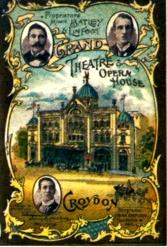Played Out In Grand Style
When Croydon Council unveiled proposals to tear down Croydon's Grand Theatre, it faced fierce opposition from residents, actors and directors.
Despite almost 100,000 people signing a petition to keep it open, councillors decided against buying the site for £75,000 and instead a 34 to 24 majority voted to demolish the site in 1959. Planning permission was granted to build an 11 storey block of shops and offices.

Image: The Grand Theatre in 1959.
Grosvenor House now marks the spot where the theatre once stood on the High Street, its simple, streamlined design in stark contrast to the majestic architecture of the Grand.
The Grand, or to give it its full title the Grand Theatre and Opera House, was opened on 6th April 1896, by actor Herbert Beerbohm Tree who staged his own production of Trilby as part of the opening ceremony.
The theatre quickly gained support from the theatrical community when A Midsummer Night's Dream played throughout the venue's opening week.
Two years later actress Sarah Bernhardt starred in La Dame Aux Camilla. The Grand's first pantomime, at the beginning of 1897 was Robinson Crusoe.
Throughout the Edwardian era there was a mixture of popular melodrama and light plays.
Thornton Heath resident Wally Plummer, a long-time member of the Croydon based musical troupe The Braganzians concert party, says it was theatrical establishments like the Grand which ignited his interest in performing.
He said: "I remember passing the Grand Theatre in the late 1940s, I must have been about 10 or 11. There was water gushing out of the stage door and I wondered what on earth was happening in there. "I later learned there was a Somerset Maugham play called Ram being performed there. It was a play about, let's say, a lady of the night and my parents thought it was too risque for me to see it.
"They used water to create rain on stage throughout the play and this came from a tap, Tarpaulin was used to protect the stage but it also redirected the water, out of the stage door and into the street.
"It's an image that has always stuck with me and the most vivid memory I have of the Grand. And it was memories like this which got me interested in performing."

The Grand was closed between 1940 and 1942 and only opened occasionally until after World War Two when Will Hammer ran long seasons of repertory and an annual pantomime until 1957.
Kenley resident Maureen Bunn recalls: "It was brilliant. It was in repertory once a week at the Grand and a lot of people who performed there went on to become very famous indeed. Just marvellous."
When plans were approved to demolish the site, attempts were made by the Council for Theatre Preservation and Croydon Theatre Trust to have the planning permission revoked by Henry Brooke, the then minister of housing and local government.
However, it was all in vain and the final show in April 1959 was No Chance for Davies, a futuristic spy story written by the Grand's last director, Michael Wide.
A plaque on the front of Grosvenor House commemorates the theatre but only old newspaper cuttings, photographs and. programmes truly captures the essence of the Grand in its heyday.
Image: Play Bill: One of the Grand earliest programmes dated 1897.
